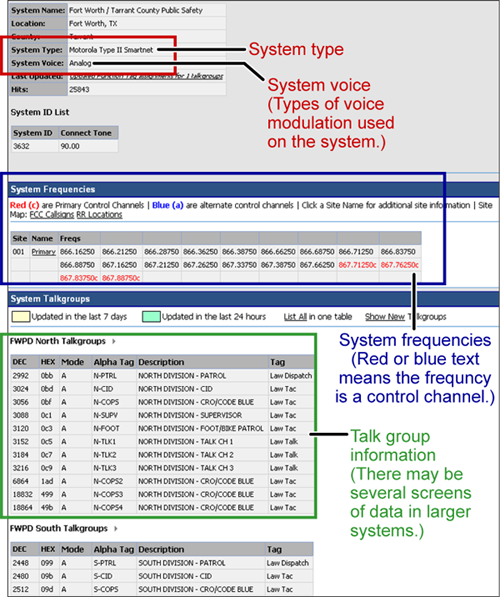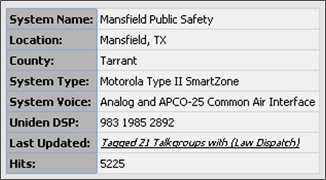Before you program a trunked system
To the average radio user, the complexity of a trunked system is invisible. Their radio is programmed up at the radio shop. They can still easily select who they need to communicate with by selecting a channel on their two-way. They can even directly call other radio users without tying up a dispatch channel — something they could never do before. As a scanner user, on the other hand, you need to know the different types of trunking systems in use, what options are available on each system, and three key pieces of information about any trunking system before you start any actual programming:
- System Type
- System Frequencies
- IDs of the Talk Groups you want to hear
All of this information is usually available from the online database at
RadioReference. The picture to the right shows a screenshot of a system from the database, with the pertinent information highlighted.
System Type
There are five major types of scannable systems; some of these also have subtypes. In the RadioReference database, you can generally determine the radio system type by looking at the line labeled
System Type at the top of the screen (inside the red square in the screenshot).
P25 Systems
These are identified in the RadioReference database as
Project 25 Standard . If the System Type line says anything else, then it is not a P25 system (even though it might have some P25 channels).
LTR Systems
These systems are identified as
LTR Standard in the system type.
Motorola Systems
There are several subcategories of Motorola systems, but they will all have some form of
Motorola in the system type:
Motorola Fleetnet ,
Motorola Smartnet ,
Motorola Smartzone , etc. Once you have identified that it is a Motorola system, you can check the system frequencies to confirm its subtype:
- Motorola 800: all of the frequencies are in the 800 MHz range
- Motorola 900: all of the frequencies are in the 900 MHz range
- Motorola UHF: all of the frequencies are between 400 and 512 MHz
- Motorola VHF: all of the frequencies are between 100 and 200 MHz.
EDACS Systems
There are three subtypes of EDACS systems:
- EDACS Wide: identified as EDACS Standard in the system type.
- EDACS Narrow: identified as EDACS Narrowband in the system type.
- EDACS SCAT: identified as EDACS Scat in the system type (these systems operate on a single frequency).
Conventional Systems
This fifth type of scannable system is a general catchall for all non-trunked systems. See
Conventional Systems for more information.
Non-scannable Systems
There are several system types that cannot be monitored with a scanner, either because the systems use proprietary digital formats that are not licensable by scanner manufacturers, or because the systems are not in wide enough use to make it cost-effective for manufacturers to develop a scanner that can monitor them.
These non-scannable systems are identified in the system type as:
- EDACS w/ESK
- LTR Passport
- OpenSky Standard
- MPT1327
- Tetra
- iDen
- MotoTRBO
- NexEdge
System Voice
The other line inside the red square in the screenshot is
System Voice , which summarizes the kinds of voice modulation used on the system. Youll find the following voice types:
- Analog (can be heard with any trunking scanner)
- APCO-25 (can be heard with a digital scanner)
- ProVoice (cannot be heard by any scanner)
- VSELP (cannot be heard by any scanner)
The system voice also tells us when digital channels are mixed in with analog channels on the same system. Unfortunately, this means the system voice line can cause a lot of confusion. Just remember: system
voice does not define the system
type .
For example, in the system information shown to the left, we see that
APCO-25 can be used as a voice type on a Motorola system that is not actually a
P25 system . When we're trying to determine whether a system is a P25 system, we need to ignore the System Voice line and focus on the
System Type line. If there is P25 Voice on a non-P25 system, the scanner can sort this out while scanning.
System Frequencies
The
system frequencies section in the database lists all the frequencies used by the system (see the blue square in the screenshot above on the right). For Motorola and P25 systems, you will need to program only the system control channel frequencies: those are the frequencies shown in red (for primary control channels) and blue (for alternate control channels) in the database.
For EDACS and LTR systems, you will need to program all the listed frequencies and their associated LCN (that is a small number right next to the frequency). Some systems have multiple sets of frequencies. These are called
multi-site systems: each set of frequencies corresponds to a different physical antenna site.
Talk Group IDs (Channels)
The Talk Group information section (inside the green rectangle) shows the different channels on the system and which agency uses them. You'll need to go through the list and make a note of the channels you want to hear. Then you can start thinking about how you want to organize those channels.
(Keep in mind that this screenshot shows just a few of the channels on a single system. One of the great features available to subscribers on RadioReference is the ability to tag channels directly on the site and print out a nicely-formatted hardcopy of each system. It makes this task much, much easier.)



